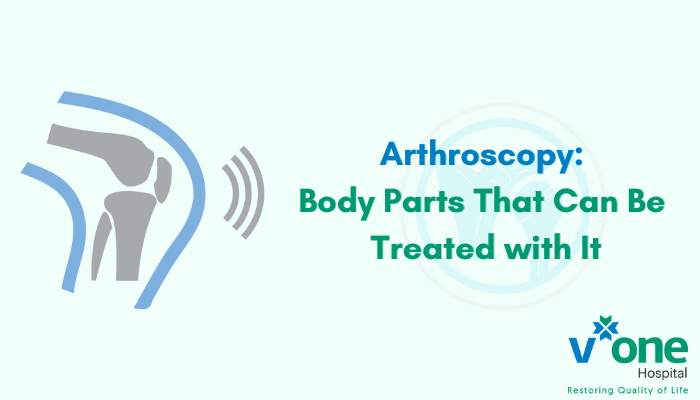Arthroscopy: Body Parts That Can Be Treated with This Procedure
The word arthroscopy comes from Greek words “arthro” (joint) and “skopein” (to look). It means “to look within the joint.”
What is Arthroscopy?
Arthroscopy is a minimally invasive surgical procedure that allows doctors to diagnose and treat problems within the joints. Arthroscopy surgeons in Indore and around the world use this technique to examine, diagnose, and treat a variety of joint-related conditions using an arthroscope (an endoscope inserted into the joint through a small incision). This is a minor surgery and you get to go home the same day (outpatient). In this article, we will discuss the different body parts on which arthroscopy is performed and the various conditions that can be treated with this procedure.
Why and Where Arthroscopy is Done?
Arthroscopy is a type of keyhole surgery that is commonly used on the knees, ankles, hips, shoulders, wrists, and elbows. By making tiny cuts on the body and inserting an arthroscope into the joints, this procedure can help you figure out what is causing the pain, swelling, and stiffness in your joints, or why your joints are locking, moving out of position, or giving way, and then repairs can be made. It can be useful if an X-ray hasn’t revealed anything.
The Meniscus
The meniscus is a C-shaped piece of cartilage in the knee joint that acts as a shock absorber between the thighbone and shinbone. Injuries to the meniscus are common in athletes, particularly those who participate in sports that involve twisting or pivoting motions. Arthroscopy surgeons in Indore frequently use arthroscopy to repair or remove torn meniscus cartilage. During the procedure, the surgeon inserts a small camera into the joint, which displays images on a monitor. The surgeon then inserts small instruments through tiny incisions to repair or remove the damaged cartilage.
Arthritis
Arthritis is a condition that causes inflammation in the joints, leading to pain, stiffness, and swelling. The most common types of arthritis are osteoarthritis and rheumatoid arthritis. Arthroscopy can be used to diagnose and treat arthritis in various joints, including the knee, shoulder, hip, and ankle. During the procedure, the surgeon can remove damaged sections of the cartilage, repair tears to the ligaments, and wash out damaged tissue using a sterile liquid. It can help relieve the pain and discomfort associated with arthritis and improve joint function.
Elbow Procedure
Arthroscopy can also be used to diagnose and treat problems in the elbow joint. The most common condition treated with surgery in the elbow joint is tennis elbow. Tennis elbow is a condition that causes pain and inflammation in the tendons that attach to the outside of the elbow. Arthroscopy surgeons in Indore carry out the procedure to remove damaged tissue. It’s a minimally invasive procedure with a high success rate.
Osteoarthritis
Osteoarthritis is a type of arthritis that occurs when the protective cartilage on the ends of bones wears down over time. This condition is most common in the hands, knees, hips, and spine. Arthroscopy can be used to diagnose and treat osteoarthritis in various joints. During the procedure, the surgeon can remove inflamed tissue, smooth rough surfaces, and remove bone spurs. Arthroscopy can help relieve the pain and discomfort associated with osteoarthritis and improve joint function.
Shoulder Arthroscopy
For shoulder arthroscopy, your surgeon will shave your shoulder and inject fluid into your shoulder to inflate the joint, then insert a small arthroscope (camera) into your shoulder joint. He can use this camera’s feed to see any damages inside the shoulder and to guide tiny surgical instruments.
Ankle Arthroscopy
During ankle arthroscopy, after numbing your leg and ankle with general anesthesia, the surgeon will insert a small arthroscope into your ankle through an incision and then inspect your cartilage, bones, tendons, and ligaments. Then, he can make a couple more incisions to insert instruments to remove damaged tissue and fix a tear in a muscle, tendon, or cartilage.
Wrist Arthroscopy
Your wrist is a complex joint with eight small bones and many connecting ligaments. By using a pencil-thin camera and tiny incisions and instruments, arthroscopy can help treat chronic wrist pain, wrist fractures, ligament tears (wrist sprains), and Ganglion cysts.
Hip Arthroscopy
A hip arthroscopy can help relieve painful symptoms of problems like a hip injury, hip dysplasia, a femoroacetabular impingement, hip joint infection, sciatic nerve compression, Synovitis, Snapping hip syndrome, loose bodies, tendon ruptures, and hip labrum tears. Depending on the situation, your surgeon may repair the labrum, remove inflamed synovial tissue, trim FAI bone spurs, or smooth torn-off cartilage.
At the end of the day, whatever the problem, arthroscopy can help relieve pain, improve joint function, and restore your quality of life. And depending on which joint was affected and whether you had any treatment, it may take you from around 1 week to several months to fully recover from the surgery, and exercise will be a big part of the recovery.

